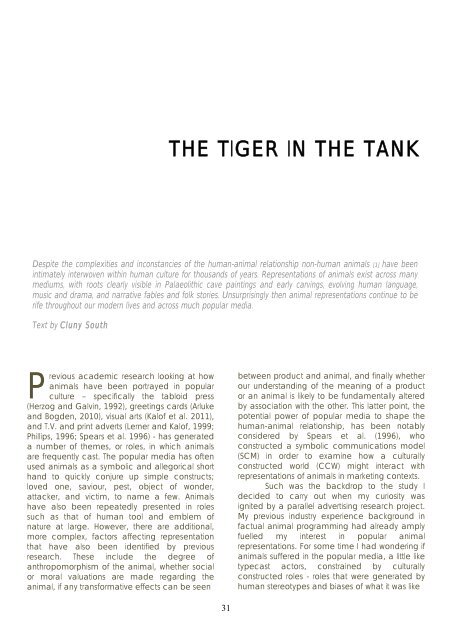Marketing Animals - Antennae The Journal of Nature in Visual Culture
Marketing Animals - Antennae The Journal of Nature in Visual Culture
Marketing Animals - Antennae The Journal of Nature in Visual Culture
Create successful ePaper yourself
Turn your PDF publications into a flip-book with our unique Google optimized e-Paper software.
P<br />
revious academic research look<strong>in</strong>g at how<br />
animals have been portrayed <strong>in</strong> popular<br />
culture – specifically the tabloid press<br />
(Herzog and Galv<strong>in</strong>, 1992), greet<strong>in</strong>gs cards (Arluke<br />
and Bogden, 2010), visual arts (Kal<strong>of</strong> et al. 2011),<br />
and T.V. and pr<strong>in</strong>t adverts (Lerner and Kal<strong>of</strong>, 1999;<br />
Phillips, 1996; Spears et al. 1996) - has generated<br />
a number <strong>of</strong> themes, or roles, <strong>in</strong> which animals<br />
are frequently cast. <strong>The</strong> popular media has <strong>of</strong>ten<br />
used animals as a symbolic and allegorical short<br />
hand to quickly conjure up simple constructs;<br />
loved one, saviour, pest, object <strong>of</strong> wonder,<br />
attacker, and victim, to name a few. <strong>Animals</strong><br />
have also been repeatedly presented <strong>in</strong> roles<br />
such as that <strong>of</strong> human tool and emblem <strong>of</strong><br />
nature at large. However, there are additional,<br />
more complex, factors affect<strong>in</strong>g representation<br />
that have also been identified by previous<br />
research. <strong>The</strong>se <strong>in</strong>clude the degree <strong>of</strong><br />
anthropomorphism <strong>of</strong> the animal, whether social<br />
or moral valuations are made regard<strong>in</strong>g the<br />
animal, if any transformative effects can be seen<br />
THE TIGER IN THE TANK<br />
Despite the complexities and <strong>in</strong>constancies <strong>of</strong> the human-animal relationship non-human animals [1] have been<br />
<strong>in</strong>timately <strong>in</strong>terwoven with<strong>in</strong> human culture for thousands <strong>of</strong> years. Representations <strong>of</strong> animals exist across many<br />
mediums, with roots clearly visible <strong>in</strong> Palaeolithic cave pa<strong>in</strong>t<strong>in</strong>gs and early carv<strong>in</strong>gs, evolv<strong>in</strong>g human language,<br />
music and drama, and narrative fables and folk stories. Unsurpris<strong>in</strong>gly then animal representations cont<strong>in</strong>ue to be<br />
rife throughout our modern lives and across much popular media.<br />
Text by Cluny South<br />
31<br />
between product and animal, and f<strong>in</strong>ally whether<br />
our understand<strong>in</strong>g <strong>of</strong> the mean<strong>in</strong>g <strong>of</strong> a product<br />
or an animal is likely to be fundamentally altered<br />
by association with the other. This latter po<strong>in</strong>t, the<br />
potential power <strong>of</strong> popular media to shape the<br />
human-animal relationship, has been notably<br />
considered by Spears et al. (1996), who<br />
constructed a symbolic communications model<br />
(SCM) <strong>in</strong> order to exam<strong>in</strong>e how a culturally<br />
constructed world (CCW) might <strong>in</strong>teract with<br />
representations <strong>of</strong> animals <strong>in</strong> market<strong>in</strong>g contexts.<br />
Such was the backdrop to the study I<br />
decided to carry out when my curiosity was<br />
ignited by a parallel advertis<strong>in</strong>g research project.<br />
My previous <strong>in</strong>dustry experience background <strong>in</strong><br />
factual animal programm<strong>in</strong>g had already amply<br />
fuelled my <strong>in</strong>terest <strong>in</strong> popular animal<br />
representations. For some time I had wonder<strong>in</strong>g if<br />
animals suffered <strong>in</strong> the popular media, a little like<br />
typecast actors, constra<strong>in</strong>ed by culturally<br />
constructed roles - roles that were generated by<br />
human stereotypes and biases <strong>of</strong> what it was like












